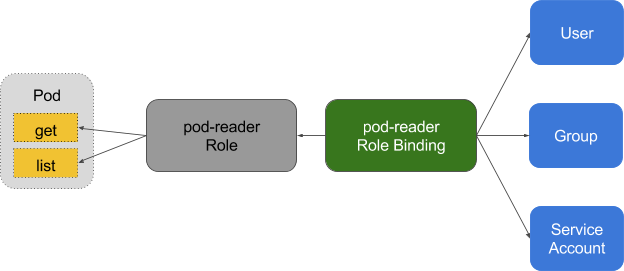## RBAC Support in Kubernetes
Kubernetes 中的 RBAC 支持
> PS:在Kubernetes1.6版本中新增角色访问控制机制(Role-Based Access,RBAC)让集群管理员可以针对特定使用者或服务账号的角色,进行更精确的资源访问控制。在RBAC中,权限与角色相关联,用户通过成为适当角色的成员而得到这些角色的权限。这就极大地简化了权限的管理。在一个组织中,角色是为了完成各种工作而创造,用户则依据它的责任和资格来被指派相应的角色,用户可以很容易地从一个角色被指派到另一个角色。
>
## RBAC vs ABAC
鉴权的作用是,决定一个用户是否有权使用 Kubernetes API 做某些事情。它除了会影响 kubectl 等组件之外,还会对一些运行在集群内部并对集群进行操作的软件产生作用,例如使用了 Kubernetes 插件的 Jenkins,或者是利用 Kubernetes API 进行软件部署的 Helm。ABAC 和 RBAC 都能够对访问策略进行配置。
ABAC(Attribute Based Access Control)本来是不错的概念,但是在 Kubernetes 中的实现比较难于管理和理解(怪我咯),而且需要对 Master 所在节点的 SSH 和文件系统权限,而且要使得对授权的变更成功生效,还需要重新启动 API Server。
而 RBAC 的授权策略可以利用 kubectl 或者 Kubernetes API 直接进行配置。RBAC 可以授权给用户,让用户有权进行授权管理,这样就可以无需接触节点,直接进行授权管理。RBAC 在 Kubernetes 中被映射为 API 资源和操作。
因为 Kubernetes 社区的投入和偏好,相对于 ABAC 而言,RBAC 是更好的选择。
## 基础概念
需要理解 RBAC 一些基础的概念和思路,RBAC 是让用户能够访问 Kubernetes API 资源的授权方式。

在 RBAC 中定义了两个对象,用于描述在用户和资源之间的连接权限。
## Role and ClusterRole
在 RBAC API 中,Role 表示一组规则权限,权限只会增加(累加权限),不存在一个资源一开始就有很多权限而通过 RBAC 对其进行减少的操作;Role 可以定义在一个 namespace 中,如果想要跨 namespace 则可以创建 ClusterRole。
### 角色
角色是一系列的权限的集合,例如一个角色可以包含读取 Pod 的权限和列出 Pod 的权限, ClusterRole 跟 Role 类似,但是可以在集群中到处使用.
**Role 只能用于授予对单个命名空间中的资源访问权限**, 以下是一个对默认命名空间中 Pods 具有访问权限的样例:
kind: Role
apiVersion: rbac.authorization.k8s.io/v1beta1
metadata:
namespace: default
name: pod-reader
rules:
- apiGroups: [""] # "" indicates the core API group
resources: ["pods"]
verbs: ["get", "watch", "list"]
ClusterRole 具有与 Role 相同的权限角色控制能力,不同的是 ClusterRole 是集群级别的,ClusterRole 可以用于:
- 集群级别的资源控制(例如 node 访问权限)
- 非资源型 endpoints(例如 /healthz 访问)
- 所有命名空间资源控制(例如 pods)
以下是 ClusterRole 授权某个特定命名空间或全部命名空间(取决于绑定方式)访问 secrets 的样例
kind: ClusterRole
apiVersion: rbac.authorization.k8s.io/v1beta1
metadata:
# "namespace" omitted since ClusterRoles are not namespaced
name: secret-reader
rules:
- apiGroups: [""]
resources: ["secrets"]
verbs: ["get", "watch", "list"]
### RoleBinding and ClusterRoleBinding
RoloBinding 可以将角色中定义的权限授予用户或用户组,RoleBinding 包含一组权限列表(subjects),**权限列表中包含有不同形式的待授予权限资源类型(users, groups, or service accounts)**;RoloBinding 同样包含对被 Bind 的 Role 引用;RoleBinding 适用于某个命名空间内授权,而 ClusterRoleBinding 适用于集群范围内的授权。

RoleBinding 可以在同一命名空间中引用对应的 Role,以下 RoleBinding 样例将 default 命名空间的 pod-reader Role 授予 jane 用户,此后 jane 用户在 default 命名空间中将具有 pod-reader 的权限
# This role binding allows "jane" to read pods in the "default" namespace.
kind: RoleBinding
apiVersion: rbac.authorization.k8s.io/v1beta1
metadata:
name: read-pods
namespace: default
subjects:
- kind: User
name: jane
apiGroup: rbac.authorization.k8s.io
roleRef:
kind: Role
name: pod-reader
apiGroup: rbac.authorization.k8s.io
**RoleBinding 同样可以引用 ClusterRole 来对当前 namespace 内用户、用户组或 ServiceAccount 进行授权,这种操作允许集群管理员在整个集群内定义一些通用的 ClusterRole,然后在不同的 namespace 中使用 RoleBinding 来引用**
例如,以下 RoleBinding 引用了一个 ClusterRole,这个 ClusterRole 具有整个集群内对 secrets 的访问权限;但是其授权用户 dave 只能访问 development 空间中的 secrets(因为 RoleBinding 定义在 development 命名空间)
# This role binding allows "dave" to read secrets in the "development" namespace.
kind: RoleBinding
apiVersion: rbac.authorization.k8s.io/v1beta1
metadata:
name: read-secrets
namespace: development # This only grants permissions within the "development" namespace.
subjects:
- kind: User
name: dave
apiGroup: rbac.authorization.k8s.io
roleRef:
kind: ClusterRole
name: secret-reader
apiGroup: rbac.authorization.k8s.io
最后,使用 ClusterRoleBinding 可以对整个集群中的所有命名空间资源权限进行授权;以下 ClusterRoleBinding 样例展示了授权 manager 组内所有用户在全部命名空间中对 secrets 进行访问
# This cluster role binding allows anyone in the "manager" group to read secrets in any namespace.
kind: ClusterRoleBinding
apiVersion: rbac.authorization.k8s.io/v1beta1
metadata:
name: read-secrets-global
subjects:
- kind: Group
name: manager
apiGroup: rbac.authorization.k8s.io
roleRef:
kind: ClusterRole
name: secret-reader
apiGroup: rbac.authorization.k8s.io
## Referring to Resources
Kubernetes 集群内一些资源一般以其名称字符串来表示,这些字符串一般会在 API 的 URL 地址中出现;同时某些资源也会包含子资源,例如 logs 资源就属于 pods 的子资源,API 中 URL 样例如下
GET /api/v1/namespaces/{namespace}/pods/{name}/log
**如果要在 RBAC 授权模型中控制这些子资源的访问权限,可以通过 / 分隔符来实现**,以下是一个定义 pods 资资源 logs 访问权限的 Role 定义样例
kind: Role
apiVersion: rbac.authorization.k8s.io/v1beta1
metadata:
namespace: default
name: pod-and-pod-logs-reader
rules:
- apiGroups: [""]
resources: ["pods", "pods/log"]
verbs: ["get", "list"]
具体的资源引用可以通过 resourceNames 来定义,当指定 get、delete、update、patch 四个动词时,可以控制对其目标资源的相应动作;以下为限制一个 subject 对名称为 my-configmap 的 configmap 只能具有 get 和 update 权限的样例
kind: Role
apiVersion: rbac.authorization.k8s.io/v1beta1
metadata:
namespace: default
name: configmap-updater
rules:
- apiGroups: [""]
resources: ["configmap"]
resourceNames: ["my-configmap"]
verbs: ["update", "get"]
**值得注意的是,当设定了 resourceNames 后,verbs 动词不能指定为 list、watch、create 和 deletecollection;因为这个具体的资源名称不在上面四个动词限定的请求 URL 地址中匹配到,最终会因为 URL 地址不匹配导致 Role 无法创建成功**
## Referring to Subjects
RoleBinding 和 ClusterRoleBinding 可以将 Role 绑定到 Subjects;Subjects 可以是 groups、users 或者 service accounts。
Subjects 中 Users 使用字符串表示,它可以是一个普通的名字字符串,如 “alice”;也可以是 email 格式的邮箱地址,如 “bob@example.com”;甚至是一组字符串形式的数字 ID。Users 的格式必须满足集群管理员配置的验证模块,RBAC 授权系统中没有对其做任何格式限定;但是 Users 的前缀 system: 是系统保留的,集群管理员应该确保普通用户不会使用这个前缀格式
Kubernetes 的 Group 信息目前由 Authenticator 模块提供,Groups 书写格式与 Users 相同,都为一个字符串,并且没有特定的格式要求;同样 system: 前缀为系统保留
具有 system:serviceaccount: 前缀的用户名和 system:serviceaccounts: 前缀的组为 Service Accounts
### Role Binding Examples
以下示例仅展示 RoleBinding 的 subjects 部分
指定一个名字为 alice@example.com 的用户
subjects:
- kind: User
name: "alice@example.com"
apiGroup: rbac.authorization.k8s.io
指定一个名字为 frontend-admins 的组
subjects:
- kind: Group
name: "frontend-admins"
apiGroup: rbac.authorization.k8s.io
指定 kube-system namespace 中默认的 Service Account
subjects:
- kind: ServiceAccount
name: default
namespace: kube-system
指定在 qa namespace 中全部的 Service Account
subjects:
- kind: Group
name: system:serviceaccounts:qa
apiGroup: rbac.authorization.k8s.io
指定全部 namspace 中的全部 Service Account
subjects:
- kind: Group
name: system:serviceaccounts
apiGroup: rbac.authorization.k8s.io
指定全部的 authenticated 用户(1.5+)
subjects:
- kind: Group
name: system:authenticated
apiGroup: rbac.authorization.k8s.io
指定全部的 unauthenticated 用户(1.5+)
subjects:
- kind: Group
name: system:unauthenticated
apiGroup: rbac.authorization.k8s.io
指定全部用户
subjects:
- kind: Group
name: system:authenticated
apiGroup: rbac.authorization.k8s.io
- kind: Group
name: system:unauthenticated
apiGroup: rbac.authorization.k8s.io
- 第一章 kubernetes 功能介绍
- 第二章 在CentOS上部署kubernetes1.7.6集群
- 第三章 创建TLS证书和秘钥
- 第四章 安装kubectl命令行工具
- 第五章 创建kubeconfig 文件
- 第六章 etcd 集群部署
- 第七章 部署k8s-master-v1.7.6节点
- 第八章 部署k8s-v1.7.6 node 节点
- 第九章 kubectl 操作示例
- 第十章 在kubernetes 部署第一个应用
- 第十一章 kubernetes之pod 调度
- 第十二章 K8S服务组件之kube-dns&Dashboard
- 第十三章 Kubernetes中的角色访问控制机制(RBAC)支持
- 第十四章 部署nginx ingress
- 第十五章 使用Prometheus监控Kubernetes集群和应用
- 第十六章 使用helm 应用部署工具
- 第十七章 kubernetes 从1.7 到1.8升级记录
- 第十八章 在kubernetes 使用ceph
- 第十九章 基于 Jenkins 的 CI/CD(一)
- 第二十章 基于jenkins的CI/CD(二)
- 第二十一章 基于prometheus自定指标HPA弹性伸缩
